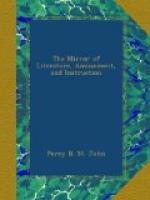“The aorta of a whale is larger in the bore than the main-pipe of the water-works at London Bridge; and the roaring in the passage through that pipe is inferior, in impetus and velocity, to the blood gushing from the whale’s heart.”
He cares not whence he fetches his illustrations, provided they are to the purpose. The laminae of the feathers of birds are kept together by teeth that hook into one another, “as a latch enters into the catch, and fastens a door.” The eyes of the mole are protected by being very small, and buried deep in a cushion of skin, so that the apertures leading to them are like pin-holes in a piece of velvet, scarcely pervious to loose particles of earth. The snail without wings, feet, or thread, adheres to a stalk by a provision of sticking-plaster. The lobster, as he grows, is furnished with a way of uncasing himself of his buckler, and drawing his legs out of his boots when they become too small for him.
In this unambitious manner does Paley prosecute his high theme, drawing, as it were, philosophy from the clouds. But it is not merely the fund of entertaining knowledge which the Natural Theology contains, or the admirable address displayed in the adaption of it, which fits it for working conviction; the “sunshine of the breast,” the cheerful spirit with which its benevolent author goes on his way ([Greek: kudei gaion],) this it is that carries the coldest reader captive, and constrains him to confess within himself, and even in spite of himself, “it is good for me to be here.”




